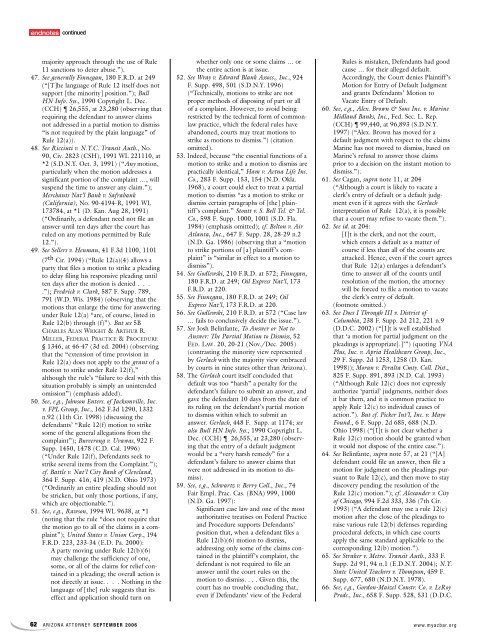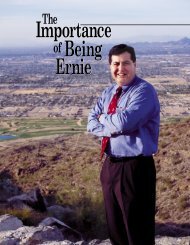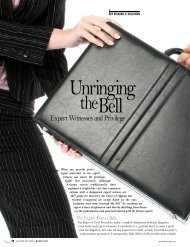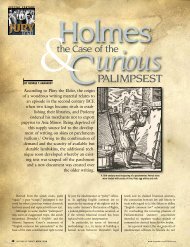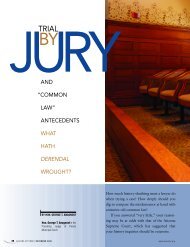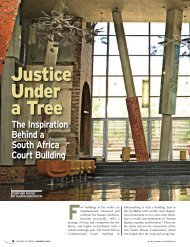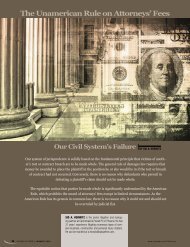The Partial Motion To Dismiss and the Defendant's ... - Lawyers
The Partial Motion To Dismiss and the Defendant's ... - Lawyers
The Partial Motion To Dismiss and the Defendant's ... - Lawyers
Create successful ePaper yourself
Turn your PDF publications into a flip-book with our unique Google optimized e-Paper software.
endnotes continuedmajority approach through <strong>the</strong> use of Rule11 sanctions to deter abuse.”).47. See generally Finnegan, 180 F.R.D. at 249(“[T]he language of Rule 12 itself does notsupport [<strong>the</strong> minority] position.”); BullHN Info. Sys., 1990 Copyright L. Dec.(CCH) 26,555, at 23,280 (observing thatrequiring <strong>the</strong> defendant to answer claimsnot addressed in a partial motion to dismiss“is not required by <strong>the</strong> plain language” ofRule 12(a)).48. See Ricciuti v. N.Y.C. Transit Auth., No.90, Civ. 2823 (CSH), 1991 WL 221110, at*2 (S.D.N.Y. Oct. 3, 1991) (“Any motion,particularly when <strong>the</strong> motion addresses asignificant portion of <strong>the</strong> complaint …, willsuspend <strong>the</strong> time to answer any claim.”);Merchants Nat’l Bank v. Safrabank(California), No. 90-4194-R, 1991 WL173784, at *1 (D. Kan. Aug 28, 1991)(“Ordinarily, a defendant need not file ananswer until ten days after <strong>the</strong> court hasruled on any motions permitted by Rule12.”).49. See Sellers v. Henman, 41 F.3d 1100, 1101(7 th Cir. 1994) (“Rule 12(a)(4) allows aparty that files a motion to strike a pleadingto delay filing his responsive pleading untilten days after <strong>the</strong> motion is denied . . ..”); Fredrick v. Clark, 587 F. Supp. 789,791 (W.D. Wis. 1984) (observing that <strong>the</strong>motions that enlarge <strong>the</strong> time for answeringunder Rule 12(a) “are, of course, listed inRule 12(b) through (f)”). But see 5BCHARLES ALAN WRIGHT & ARTHUR R.MILLER, FEDERAL PRACTICE & PROCEDURE§ 1346, at 46-47 (3d ed. 2004) (observingthat <strong>the</strong> “extension of time provision inRule 12(a) does not apply to <strong>the</strong> grant of amotion to strike under Rule 12(f),”although <strong>the</strong> rule’s “failure to deal with thissituation probably is simply an unintendedomission”) (emphasis added).50. See, e.g., Johnson Enters. of Jacksonville, Inc.v. FPL Group, Inc., 162 F.3d 1290, 1332n.92 (11th Cir. 1998) (discussing <strong>the</strong>defendants’ “Rule 12(f) motion to strikesome of <strong>the</strong> general allegations from <strong>the</strong>complaint”); Bureerong v. Uvawas, 922 F.Supp. 1450, 1478 (C.D. Cal. 1996)(“Under Rule 12(f), Defendants seek tostrike several items from <strong>the</strong> Complaint.”);cf. Battle v. Nat’l City Bank of Clevel<strong>and</strong>,364 F. Supp. 416, 419 (N.D. Ohio 1973)(“Ordinarily an entire pleading should notbe stricken, but only those portions, if any,which are objectionable.”).51. See, e.g., Rawson, 1994 WL 9638, at *1(noting that <strong>the</strong> rule “does not require that<strong>the</strong> motion go to all of <strong>the</strong> claims in a complaint”);United States v. Union Corp., 194F.R.D. 223, 233-34 (E.D. Pa. 2000):A party moving under Rule 12(b)(6)may challenge <strong>the</strong> sufficiency of one,some, or all of <strong>the</strong> claims for relief containedin a pleading; <strong>the</strong> overall action isnot directly at issue. . . . Nothing in <strong>the</strong>language of [<strong>the</strong>] rule suggests that itseffect <strong>and</strong> application should turn onwhe<strong>the</strong>r only one or some claims … or<strong>the</strong> entire action is at issue.52. See Wray v. Edward Blank Assocs., Inc., 924F. Supp. 498, 501 (S.D.N.Y. 1996)(“Technically, motions to strike are notproper methods of disposing of part or allof a complaint. However, to avoid beingrestricted by <strong>the</strong> technical form of commonlawpractice, which <strong>the</strong> federal rules haveab<strong>and</strong>oned, courts may treat motions tostrike as motions to dismiss.”) (citationomitted).53. Indeed, because “<strong>the</strong> essential functions of amotion to strike <strong>and</strong> a motion to dismiss arepractically identical,” Ham v. Aetna Life Ins.Co., 283 F. Supp. 153, 154 (N.D. Okla.1968), a court could elect to treat a partialmotion to dismiss “as a motion to strike ordismiss certain paragraphs of [<strong>the</strong>] plaintiff’scomplaint.” Stoutt v. S. Bell Tel. & Tel.Co., 598 F. Supp. 1000, 1001 (S.D. Fla.1984) (emphasis omitted); cf. Belton v. AirAtlanta, Inc., 647 F. Supp. 28, 28-29 n.2(N.D. Ga. 1986) (observing that a “motionto strike portions of [a] plaintiff’s complaint”is “similar in effect to a motion todismiss”).54. See Godlewski, 210 F.R.D. at 572; Finnegan,180 F.R.D. at 249; Oil Express Nat’l, 173F.R.D. at 220.55. See Finnegan, 180 F.R.D. at 249; OilExpress Nat’l, 173 F.R.D. at 220.56. See Godlewski, 210 F.R.D. at 572 (“Case law… fails to conclusively decide <strong>the</strong> issue.”).57. See Josh Belinfante, <strong>To</strong> Answer or Not toAnswer: <strong>The</strong> <strong>Partial</strong> <strong>Motion</strong> to <strong>Dismiss</strong>, 52FED. LAW. 20, 20-21 (Nov./Dec. 2005)(contrasting <strong>the</strong> minority view representedby Gerlach with <strong>the</strong> majority view embracedby courts in nine states o<strong>the</strong>r than Arizona).58. <strong>The</strong> Gerlach court itself concluded thatdefault was too “harsh” a penalty for <strong>the</strong>defendant’s failure to submit an answer, <strong>and</strong>gave <strong>the</strong> defendant 10 days from <strong>the</strong> date ofits ruling on <strong>the</strong> defendant’s partial motionto dismiss within which to submit ananswer. Gerlach, 448 F. Supp. at 1174; seealso Bull HN Info. Sys., 1990 Copyright L.Dec. (CCH) 26,555, at 23,280 (observingthat <strong>the</strong> entry of a default judgmentwould be a “very harsh remedy” for adefendant’s failure to answer claims thatwere not addressed in its motion to dismiss).59. See, e.g., Schwartz v. Berry Coll., Inc., 74Fair Empl. Prac. Cas. (BNA) 999, 1000(N.D. Ga. 1997):Significant case law <strong>and</strong> one of <strong>the</strong> mostauthoritative treatises on Federal Practice<strong>and</strong> Procedure supports Defendants’position that, when a defendant files aRule 12(b)(6) motion to dismiss,addressing only some of <strong>the</strong> claims containedin <strong>the</strong> plaintiff’s complaint, <strong>the</strong>defendant is not required to file ananswer until <strong>the</strong> court rules on <strong>the</strong>motion to dismiss. . . . Given this, <strong>the</strong>court has no trouble concluding that,even if Defendants’ view of <strong>the</strong> FederalRules is mistaken, Defendants had goodcause … for <strong>the</strong>ir alleged default.Accordingly, <strong>the</strong> Court denies Plaintiff’s<strong>Motion</strong> for Entry of Default Judgment<strong>and</strong> grants Defendants’ <strong>Motion</strong> toVacate Entry of Default.60. See, e.g., Alex. Brown & Sons Inc. v. MarineMidl<strong>and</strong> Banks, Inc., Fed. Sec. L. Rep.(CCH) 99,440, at 96,893 (S.D.N.Y.1997) (“Alex. Brown has moved for adefault judgment with respect to <strong>the</strong> claimsMarine has not moved to dismiss, based onMarine’s refusal to answer those claimsprior to a decision on <strong>the</strong> instant motion todismiss.”).61. See Cagan, supra note 11, at 204(“Although a court is likely to vacate aclerk’s entry of default or a default judgmenteven if it agrees with <strong>the</strong> Gerlachinterpretation of Rule 12(a), it is possiblethat a court may refuse to vacate <strong>the</strong>m.”).62. See id. at 204:[I]t is <strong>the</strong> clerk, <strong>and</strong> not <strong>the</strong> court,which enters a default as a matter ofcourse if less than all of <strong>the</strong> counts areattacked. Hence, even if <strong>the</strong> court agreesthat Rule 12(a) enlarges a defendant’stime to answer all of <strong>the</strong> counts untilresolution of <strong>the</strong> motion, <strong>the</strong> attorneywill be forced to file a motion to vacate<strong>the</strong> clerk’s entry of default.(footnote omitted.)63. See Does I Through III v. District ofColumbia, 238 F. Supp. 2d 212, 221 n.9(D.D.C. 2002) (“[I]t is well establishedthat ‘a motion for partial judgment on <strong>the</strong>pleadings is appropriate[.]’”) (quoting VNAPlus, Inc. v. Apria Healthcare Group, Inc.,29 F. Supp. 2d 1253, 1258 (D. Kan.1998)); Moran v. Peralta Cmty. Coll. Dist.,825 F. Supp. 891, 893 (N.D. Cal. 1993)(“Although Rule 12(c) does not expresslyauthorize ‘partial’ judgments, nei<strong>the</strong>r doesit bar <strong>the</strong>m, <strong>and</strong> it is common practice toapply Rule 12(c) to individual causes ofaction.”). But cf. Picker Int’l, Inc. v. MayoFound., 6 F. Supp. 2d 685, 688 (N.D.Ohio 1998) (“[I]t is not clear whe<strong>the</strong>r aRule 12(c) motion should be granted whenit would not dispose of <strong>the</strong> entire case.”).64. See Belinfante, supra note 57, at 21 (“[A]defendant could file an answer, <strong>the</strong>n file amotion for judgment on <strong>the</strong> pleadings pursuantto Rule 12(c), <strong>and</strong> <strong>the</strong>n move to staydiscovery pending <strong>the</strong> resolution of <strong>the</strong>Rule 12(c) motion.”); cf. Alex<strong>and</strong>er v. Cityof Chicago, 994 F.2d 333, 336 (7th Cir.1993) (“A defendant may use a rule 12(c)motion after <strong>the</strong> close of <strong>the</strong> pleadings toraise various rule 12(b) defenses regardingprocedural defects, in which case courtsapply <strong>the</strong> same st<strong>and</strong>ard applicable to <strong>the</strong>corresponding 12(b) motion.”).65. See Straker v. Metro. Transit Auth., 333 F.Supp. 2d 91, 94 n.1 (E.D.N.Y. 2004); N.Y.State United Teachers v. Thompson, 459 F.Supp. 677, 680 (N.D.N.Y. 1978).66. See, e.g., Gordon-Maizel Constr. Co. v. LeRoyProds., Inc., 658 F. Supp. 528, 531 (D.D.C.62 ARIZONA ATTORNEY SEPTEMBER 2006www.myazbar.org


